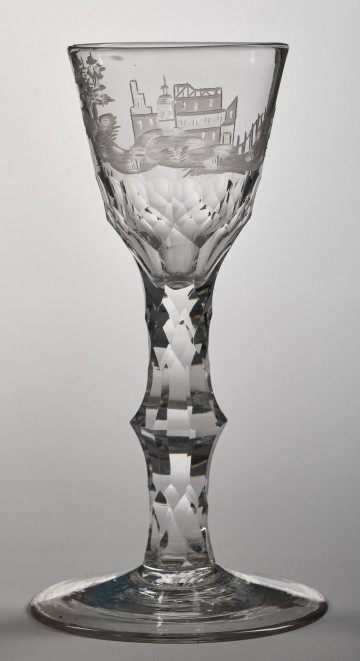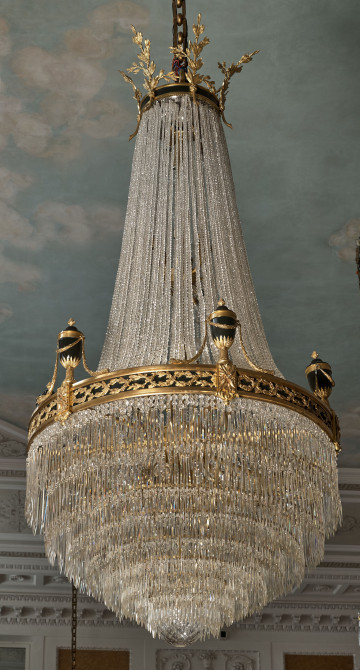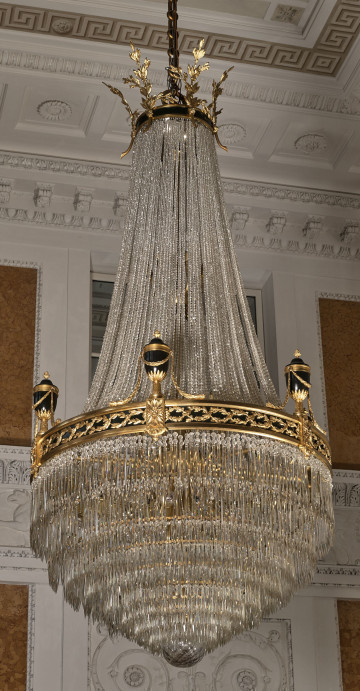
Glass with a castle motif
18th century
Castle Museum in Łańcut
Part of the collection: Lampy, żyrandole i kinkiety
The chandelier is a type of candle holder fixed to the ceiling of a room; its size and structure varies greatly depending on the room – from small to structurally complex ones made up of a high number of decorative glass or crystal elements. Its history reaches back to the middle ages (5th century), where in sacral art, and castles, it was used to light large rooms. These were fairly simple structures shaped as wooden crosses fixed to ceilings, with arms, on which candles were placed. Cross-type chandeliers were prevalent, as time passed, wrought iron structures shaped as circles, and objects of bronze, became popular, with the latter ones only in richer properties. Round, or circular, chandeliers, were based on wheels, where the arms holding candles were fixed to the rim; as time passed, they became richly decorated with crystal pendants. The crystal, circular chandelier, in the style of Louis XV, is one of the three decorating the Great Dining Hall at the castle of Łańcut. The chandelier is pear-shaped, holding eighteen candles, the stem of which is a thick, vertical metal bar, to which two metal rings are fixed, along with colour light bulbs. The light bulbs emit light through a tungsten filament that is heated (due to the flow of electricity). Despite the presently broad use of light bulbs, they are not as efficient a light source as one could believe, because only about 5% of the energy (current flow through the filament) is expelled as light, and 95% is emitted as heat. The chandelier is decorated by vertical rows of thick crystal beads – from the upper rim to the middle rim, and from the middle one to the base, creating a dome on the underside. The chandelier is finished with a metal rosette of decorative acanthus leaves with cones. The middle rim is decorated with a gilded geometric ornament. The rim bears twelve twisted arms with bobeches and minor sleeves for setting the candles. As a light source, the candle was in common use until the invention of the light bulb, meaning, until the 19th century, afterwards its use was guided by aesthetic considerations. Candles were known in antiquity, their wicks were made of linen coated with beeswax, with the homes of those less well off using animal tallow (tallow candles). Contemporary bees wax candles are equally expansive, hence the majority is made of paraffin or stearin. The upper edge of the rim holds six decorative candle holders, also with bobeches and sleeves for the candles. On the top, the chandelier is closed off by a minor ring, from which palmette protrusions emerge in a radiant manner. The garlands, in the form of festoons, are also spread among the twelve arms of the chandelier. The chandelier stems from the end of the 19th and the beginning of the 20th centuries, and is most likely French.
Object type
Lamps, chandeliers and sconces
Technique
installation
Material
glass, wood
Creation time / dating
Owner
Castle Museum in Łańcut
Identification number
Location / status

18th century
Castle Museum in Łańcut

19th (?) century
Castle Museum in Łańcut

19th (?) century
Castle Museum in Łańcut
DISCOVER this TOPIC
National Museum in Lublin
DISCOVER this PATH
Educational path